If you’re looking for an elegant yet easy dinner, this salmon with Alfredo is the perfect recipe! With flaky, buttery baked salmon paired with rich, creamy fettuccine Alfredo, this dish delivers a restaurant-quality meal with minimal effort.
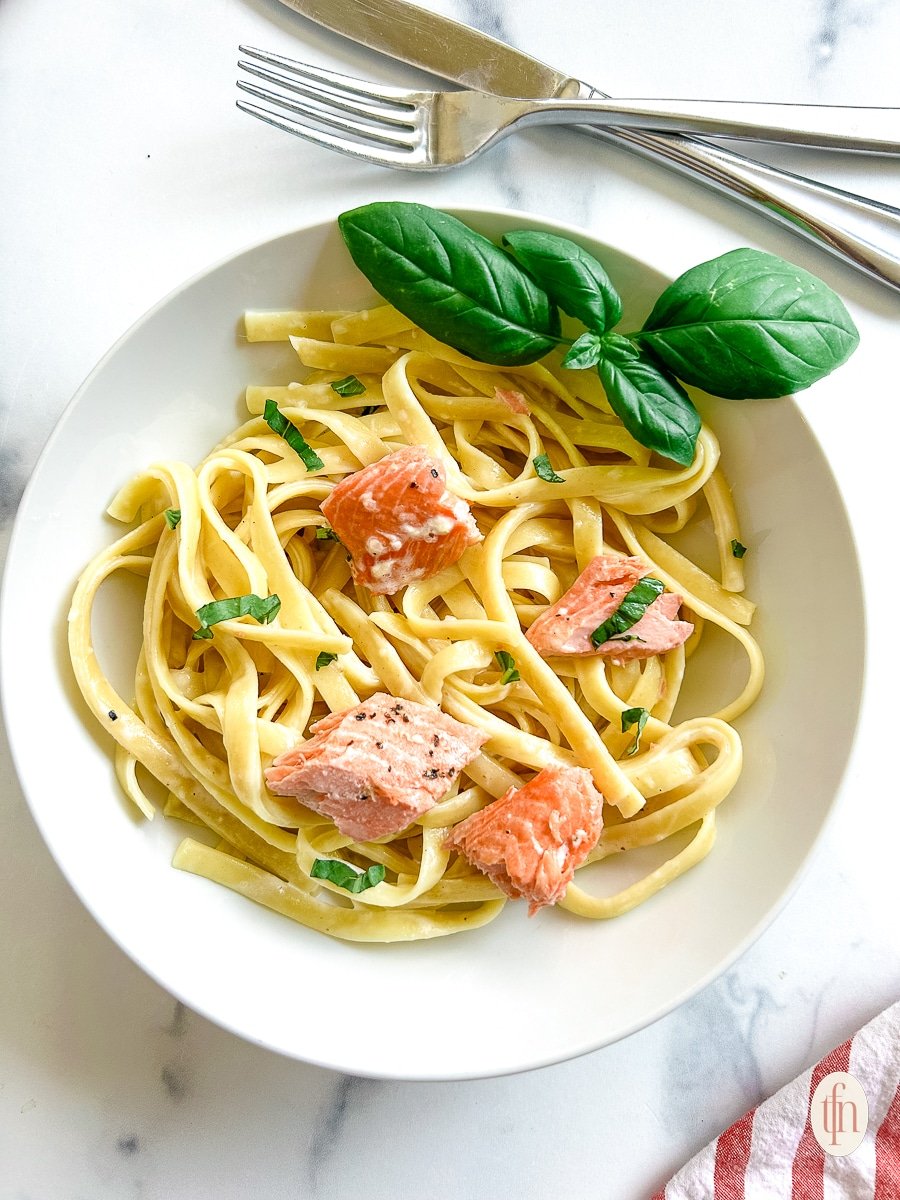
One of the best things about Alfredo with salmon is how effortlessly it comes together—less than 30 minutes from start to finish! This makes it an ideal choice for busy weeknight dinners when you want something rich and satisfying without spending hours in the kitchen.
The combination of flaky, buttery salmon and creamy Alfredo sauce creates a restaurant-quality meal that feels both indulgent and comforting. Whether you’re in the mood for a classic Italian salmon recipe or looking for an easy way to elevate your pasta night, this salmon Alfredo is guaranteed to impress with its simple yet luxurious flavors.
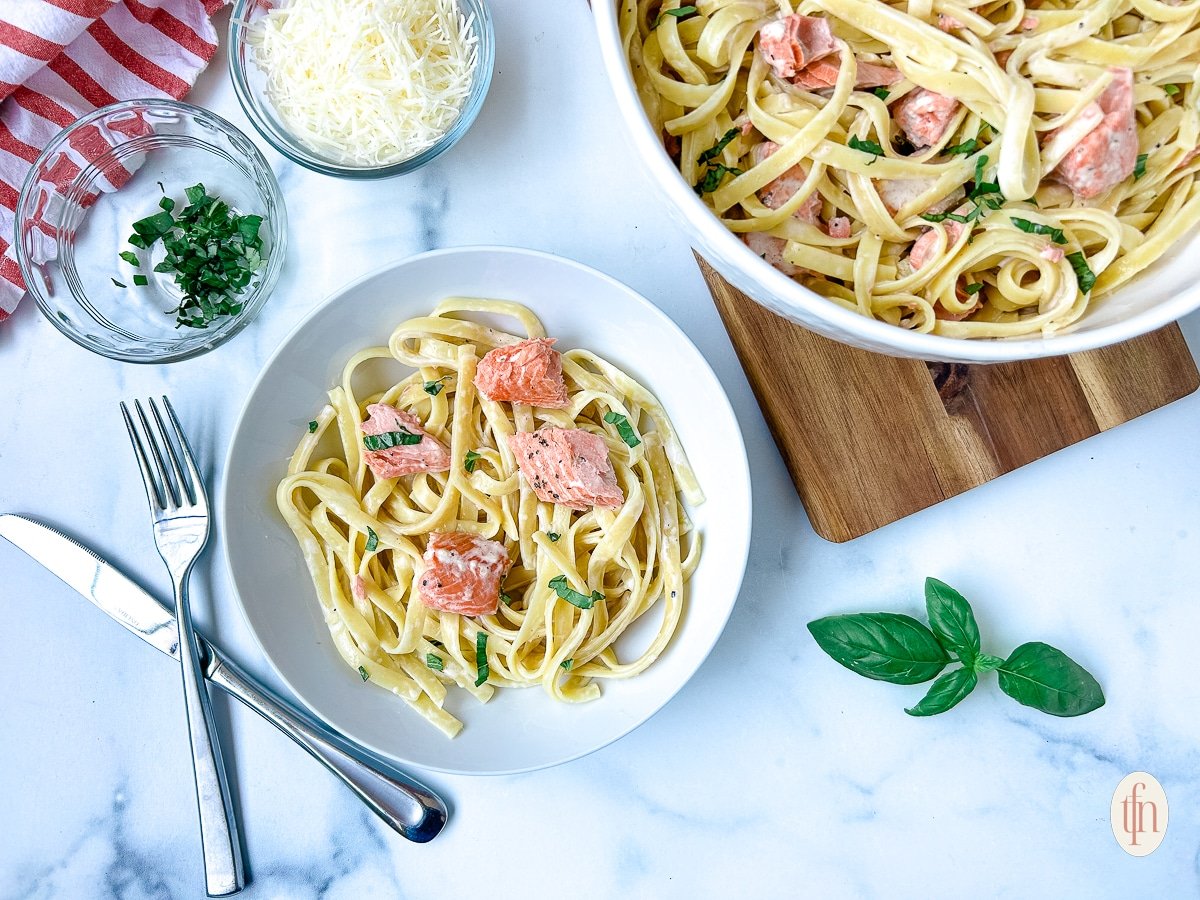
Content Covered Here
Why We Love Salmon Alfredo
- A quick recipe for a restaurant-quality meal.
This salmon with Alfredo comes together fast, making it perfect for busy nights. Just like our rigatoni con pomodoro and 30-minute pasta with meat sauce, this dish delivers big flavors with minimal effort. Plus, the salmon can be prepped ahead, making dinner time even easier! - It fills you up, but it isn’t too heavy.
One of the best things about this recipe is that it’s creamy and satisfying without feeling overly rich. Unlike heavier dishes like lasagna, this meal keeps you full without making you feel sluggish, making it a great choice for any time of year. - A light & fresh alternative
If you love this dish, you might also enjoy our salmon pesto pasta recipe, which offers a lighter, brighter flavor profile—perfect for a fresh and easy summer time meal!
Ingredient Notes and Substitutions
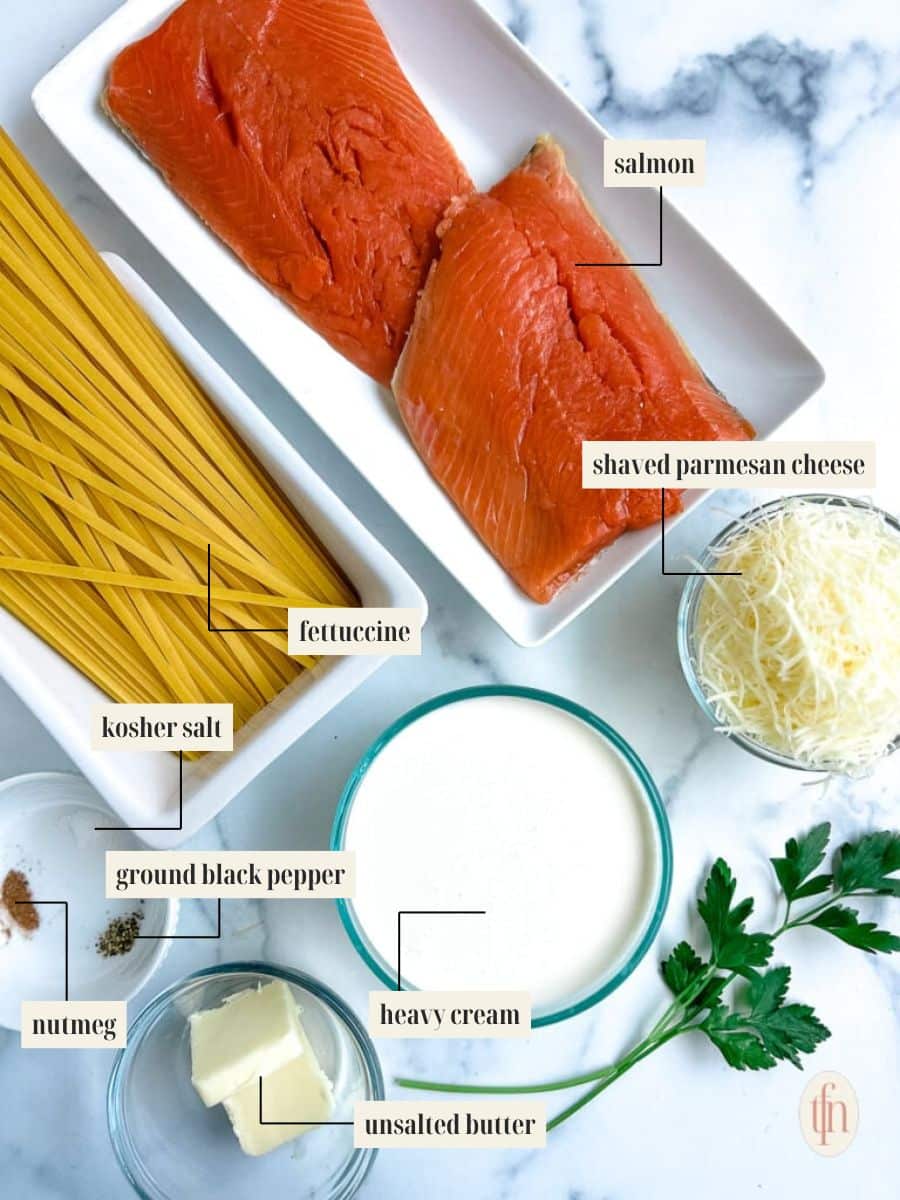
- Salmon: Skin-on filets are best for an abundance of flavor and texture. Sockeye, King, and Atlantic filets are all good options.
- Fettuccine: Other long strand pastas will work, too. Good substitutes are angel hair, linguine, tagliatelle, spaghetti, and even spaghettini will be delicious with a coating of creamy sauce!
- Heavy cream: We don’t recommend using low-fat substitutes in salmon alfredo — see our recipe tips for more information.
- Parmesan: Freshly shredded cheese will melt down miles better than pre-shredded cheese. The best substitutes are Gruyere and Pecorino Romano.
- Nutmeg: This may be surprising to see, but nutmeg is a traditional ingredient in Alfredo for a bit of warmth. Mace, garam masala, and ground cloves are good substitutes.
Recipe Variations
- Swap the pasta: While fettuccine is a classic choice, you can use linguine, penne, rigatoni, or even spaghetti to switch up the texture. For a lower-carb option, try zucchini noodles or spaghetti squash.
- Try a different protein: Not a fan of salmon? Swap it for grilled shrimp, chicken, or scallops to create a different take on Alfredo with salmon.
- Add some greens: Stir in spinach, arugula, or kale for extra nutrients and a pop of color. For a more Italian-inspired twist, add sun-dried tomatoes, roasted bell peppers, or artichoke hearts.
- Spice it up: If you love a little heat, sprinkle in some red pepper flakes or Cajun seasoning to give your pasta a spicy kick.
- Make it extra cheesy: Upgrade the sauce by mixing in Parmesan, Romano, or even a little goat cheese for a richer and creamier taste.
- Dairy-free alternative: Use coconut cream or cashew-based Alfredo sauce instead of traditional cream and butter for a dairy-free version of this dish.
- Lighten it up: Instead of heavy cream, make a lighter Alfredo sauce using Greek yogurt, low-fat milk, or a broth-based sauce for a healthier twist without sacrificing flavor.
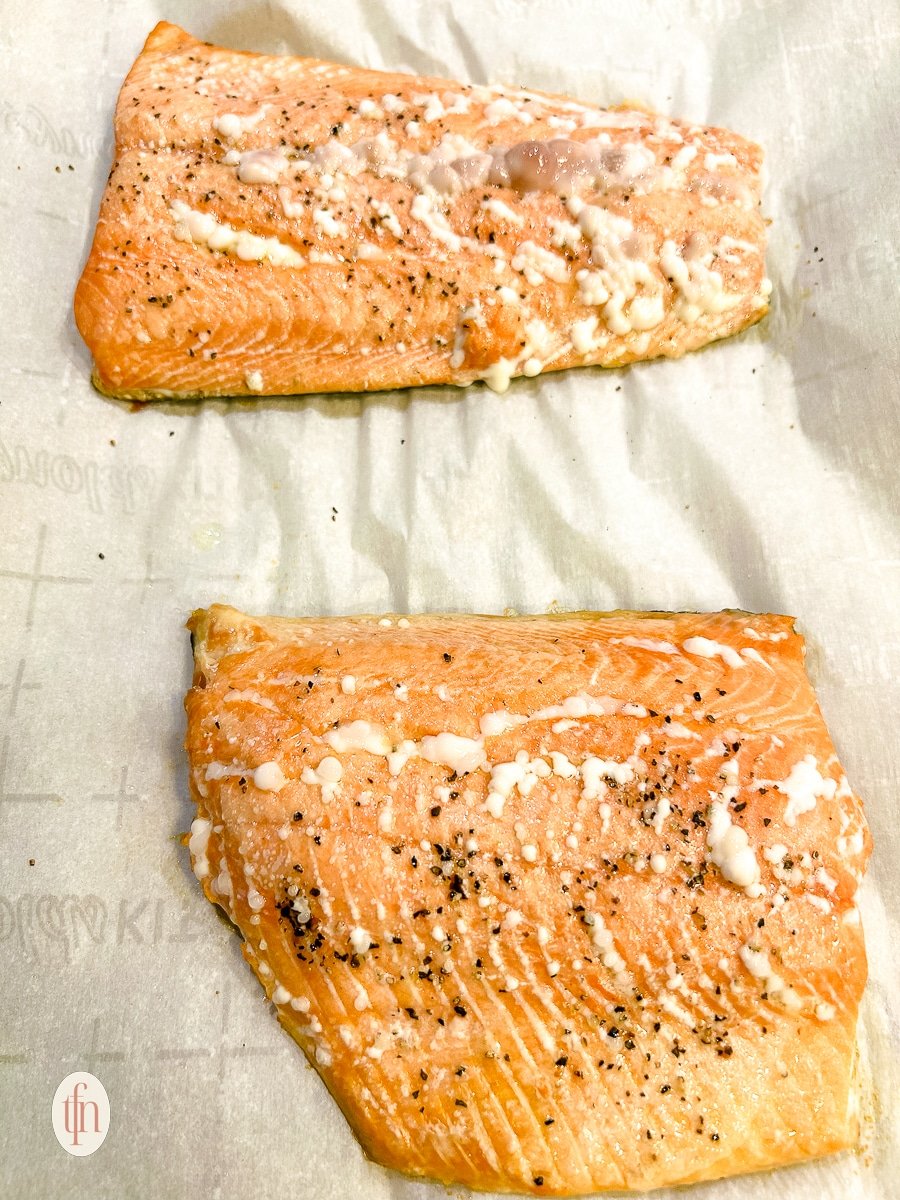
Best Practices for Seasoning Salmon and Pasta
- All this fresh-tasting salmon fettuccine requires is a light dusting of salt and pepper. That’s it!
- Like with mild-tasting white fish, this is the best way to enjoy the flavor of the baked fish without overpowering it — after all, the sauce is loaded with flavor as-is.
- Herbs are the best additional seasoning for this pasta, if you truly wish to go the extra mile. Rosemary and thyme both taste lovely with both the filets and Italian notes in the pasta.
🎯 TFN Pro Tip
Making any baked fish with slices of lemon or lemon zest in the pan is also never a bad idea to add some extra vibrancy and acidity to the dish.
Equipment Used in this Recipe
- Stock pot
- Glass measuring cups
- Colander
- Skillet
- Rimmed baking sheet
- Tongs
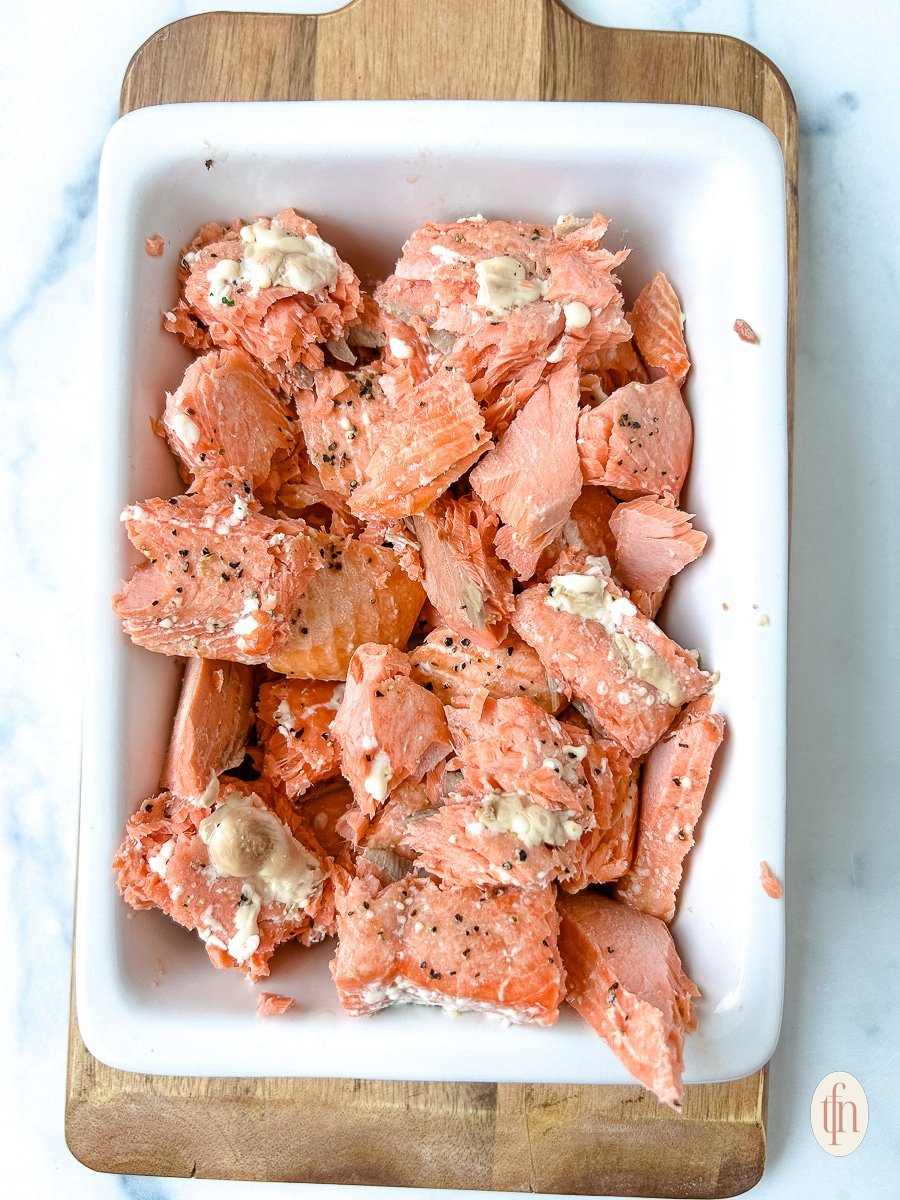
How to Make Alfredo with Salmon
- Have everything ready to use before you begin.
There is a bit of concurrent cooking involved in our Italian salmon recipe. You’ll be going back and forth between the salmon, Alfredo, and fettuccine, so be sure everything is close by and ready to use.
Before you start, preheat the oven and fill the pot with water.
When the fish is in the oven, you’ll start working on the sauce. Start boiling the water and begin reducing the cream. Keep going back and forth so that you can salt the pasta water once it hits a rolling boil while continuously stirring the cream.
The sauce only needs 8 minutes to cook, and you need to take care not to let the baked fish sit in the oven for longer than 12 minutes. Otherwise, it can overcook and become dry. - Avoid overcooking the pasta.
Meanwhile, you’ll want to cook the fettuccine al dente, which is generally 2-3 minutes less than the time suggested on the package of pasta.
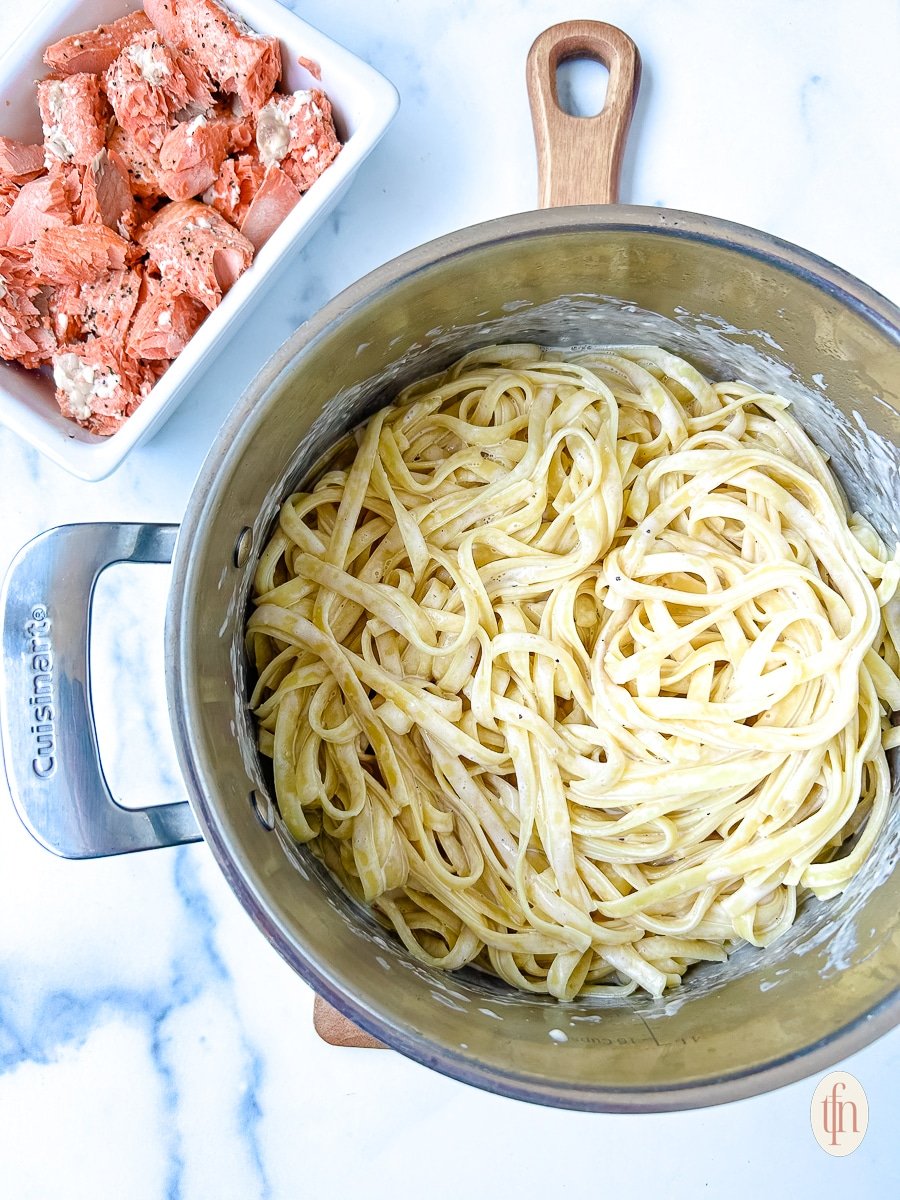
- Be sure to reserve some pasta cooking water.
The starches in the cooking water help to loosen up the sauce, and also help it cling to the fettuccine.
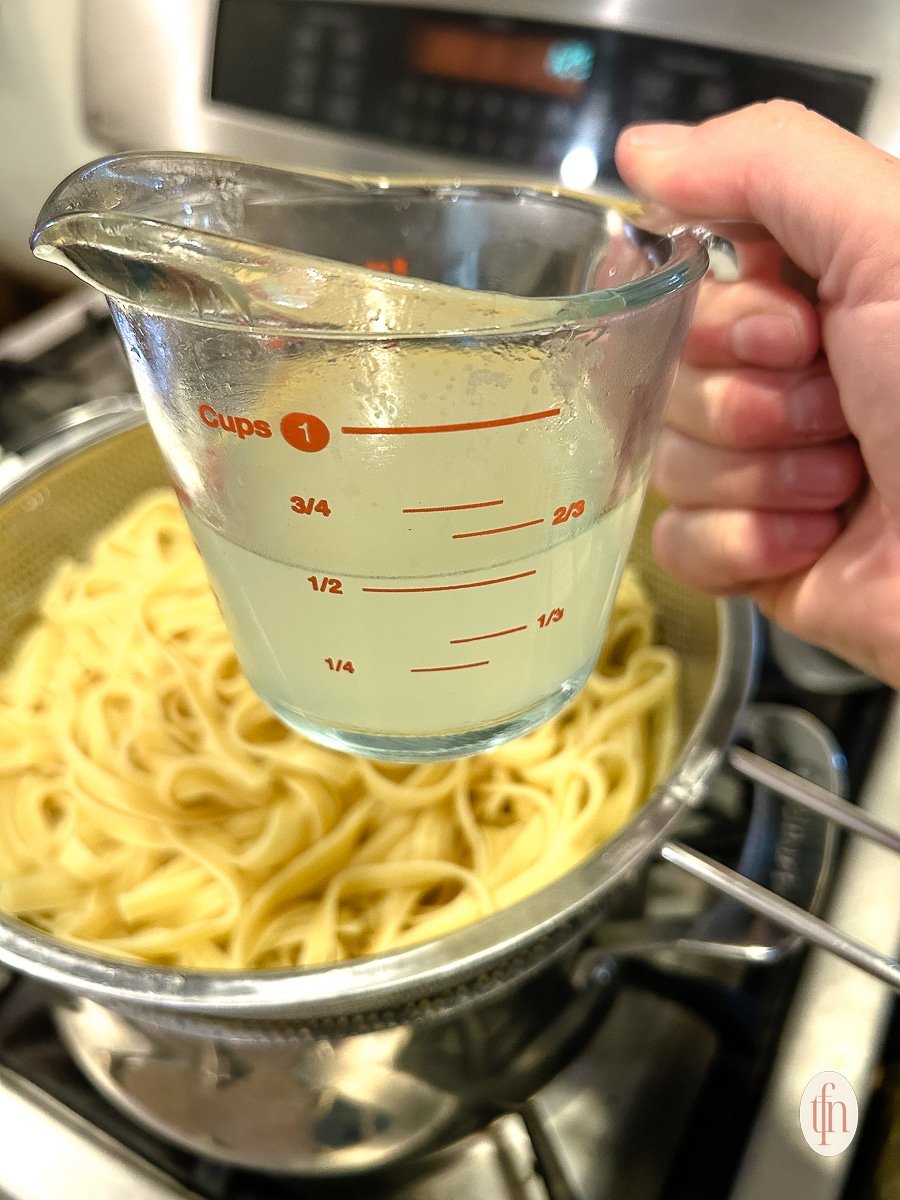
Making Silky Smooth Sauce
Making the sauce for this recipe is the definition of slow and steady. There are 3 important tips to keep in mind:
- Gradually reduce the cream, to prevent it from separating. Otherwise, it will take on a grainy, gritty texture.
- Use freshly grated cheese. Pre-shredded cheese contains a starch that prevents the shreds from clumping in the bag. Ultimately, the cheese becomes clumpy as it melts down.
- Finally, don’t use low-fat dairy. The fat is important for seamlessly melting the cheese into the cream-based sauce.
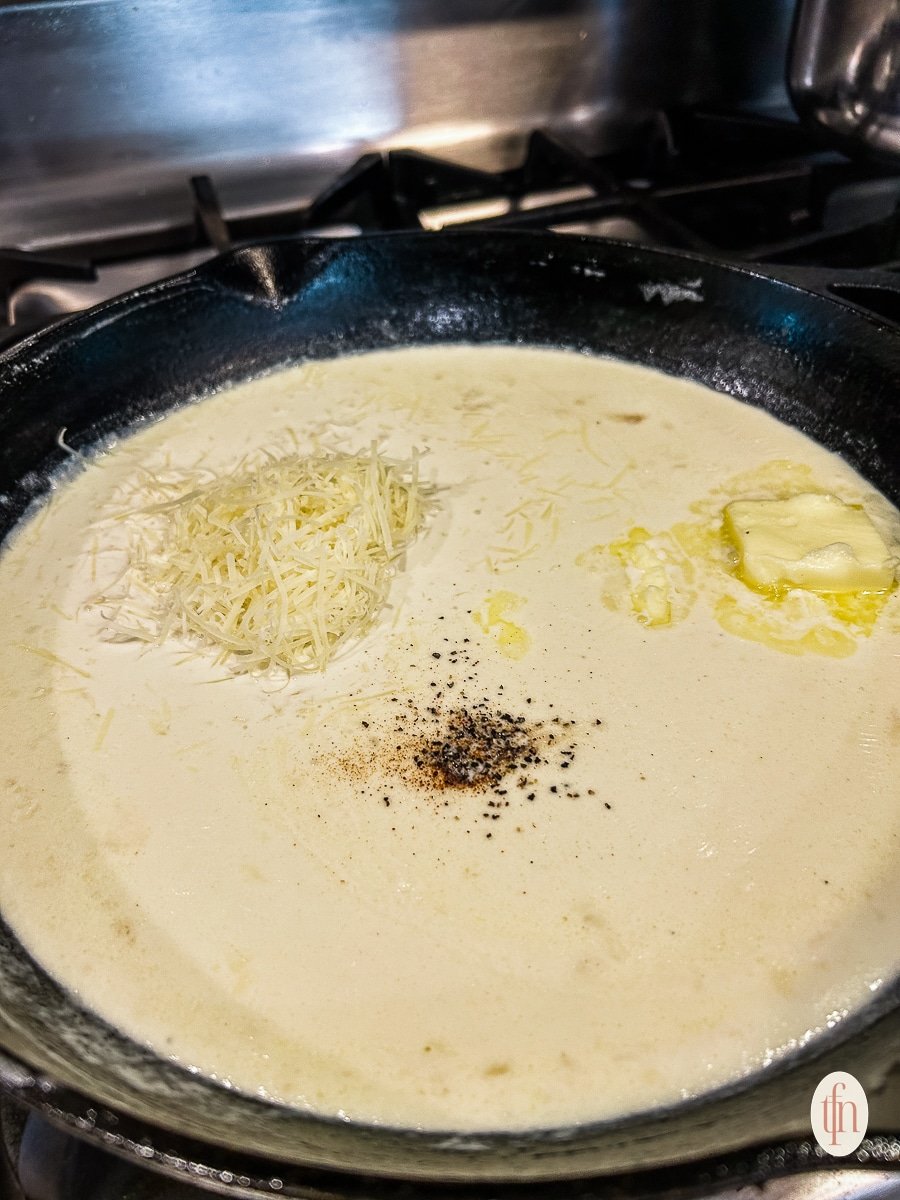
Serving Suggestions
This salmon Alfredo is the perfect comforting yet elegant dish to enjoy in February, whether you’re planning a cozy date night or a family dinner. The rich, creamy sauce pairs beautifully with fresh herbs like parsley and seasonal ingredients that elevate the dish. Serve it alongside steamed broccoli, roasted asparagus, or sautéed mushrooms for a well-rounded meal. A squeeze of lemon juice over the salmon fillet adds a bright, refreshing contrast to the richness of the Alfredo sauce. For a heartier meal, pair it with a fresh side salad featuring avocados or a light citrus dressing. Be sure to check out our February recipes for even more delicious, seasonal inspiration to complete your meal!
Recipe FAQs
The calorie count varies, depending on whether the fish is farmed or wild caught, the exact variety (Sockeye, King, or Atlantic), and how it’s prepared. For baked fish, the calories for a 4-ounce portion are generally between 150 and 210 calories.
The sauce for salmon fettuccine alfredo may seem thin at first, but be patient; It needs to reduce gradually, at a lower temperature. It will thicken even more when the butter and cheese are added.
If the sauce is still thinner than you’d like after all ingredients are added, you can continue to reduce the cream for a short while. Or, a quicker, easier option is to add more parmesan for a thicker (although cheesier and gooier) sauce.
Leftovers can be stored in an airtight container storage in the fridge for up to 4 days. This meal should not be frozen as the fat in the cream will separate once thawed because of the cream in the sauce.
We recommend storing the baked fish and fettuccine separately so that the fishy flavor doesn’t seep into the sauce and overtake the whole dish.
To prevent the sauce from separating, reheat slowly in short 10-15 second bursts in the microwave, stirring in between.
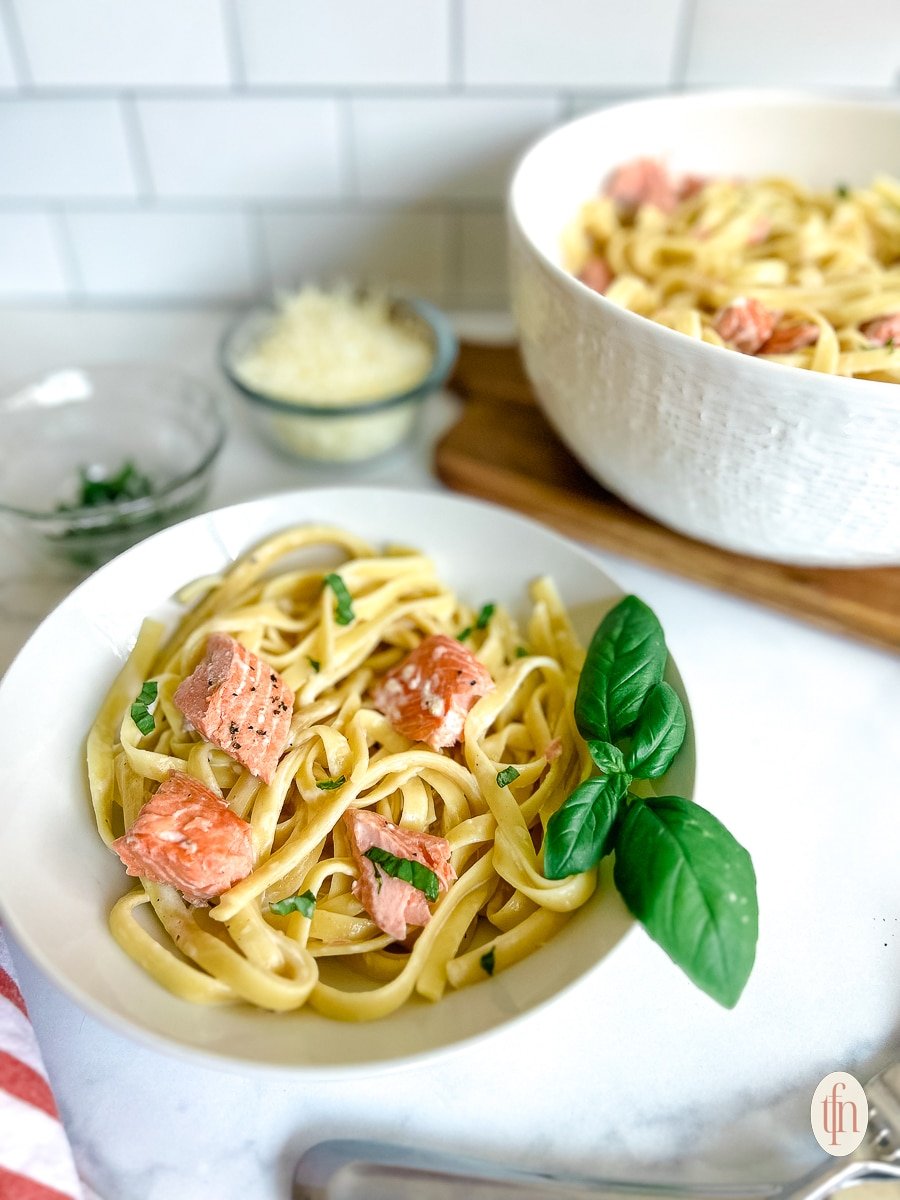
More Easy Pasta Recipes To Love…
If you tried this salmon with alfredo recipe or any other recipe on my website, please leave a 🌟 star rating and let me know how it went in the 📝 comments below. Thanks for visiting!
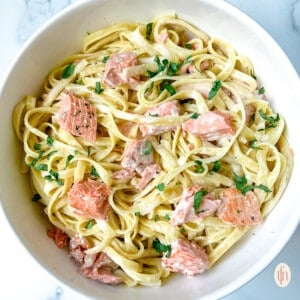
Salmon with Alfredo
Equipment
- stock pot
- glass measuring cups
- colander
- skillet
- rimmed baking sheet
- tongs
Ingredients
- 1 ½ pounds salmon six (4-ounce) skin-on filets of Sockeye, King, or Atlantic salmon
- 1 teaspoon kosher salt
- ¾ teaspoon coarsely ground black pepper
- 1 pound fettuccine or other fresh or dried long pasta or noodle of choice
- 2 cups heavy cream
- 2 tablespoons unsalted butter
- 1 cup shaved parmesan cheese
- 1 pinch nutmeg
- salt and black pepper to taste
Instructions
- Set oven to 400°F.
- Arrange salmon filets, skin side down, on a large rimmed baking sheet lined with parchment paper. Sprinkle each filet with some of the salt and pepper.Bake salmon in preheated oven for 10-12 minutes, or until fish flakes easily with a fork.
- Meanwhile, as the fish cooks, bring 4 quarts of water to a heavy boil in a large pot over high heat. Add 1 tablespoon salt to the boiling water, then add the fettuccine. Cook pasta to al dente (about 2 minutes less than stated on pasta package directions).
- Meanwhile, as the fettuccine cooks, prepare the alfredo sauce. Add cream to a 12-inch (or larger) skillet. Cook over medium heat until cream thickens slightly and reduces to approximately 1.5 cups. This will take about 8 minutes.
- Remove salmon from oven and set aside to cool. When cool enough to handle, use your fingers to loosen and remove the skin from each filet. Chop or flake fish into large chunks and set aside. *Optional – see Notes.
- When pasta is cooked to al dente, reserve 1/2 cup of the pasta water in a heat-safe measuring cup. Set the water aside, then drain the remaining water and pasta through a colander. Return pasta to the pot it was cooked in.
- Whisk the butter, parmesan cheese, and nutmeg into the reduced cream, then taste the sauce and season with salt and pepper as needed. Pour the sauce into the pot of pasta; using tongs, toss to coat. Gradually whisk in the reserved pasta water, a little at a time, to allow the sauce to cling better to the pasta. Add salmon pieces to the pasta and sauce and very gently toss with tongs to coat with sauce. Alternatively, arrange fish over the top of the fettuccine alfredo.Serve salmon alfredo pasta while it's warm.
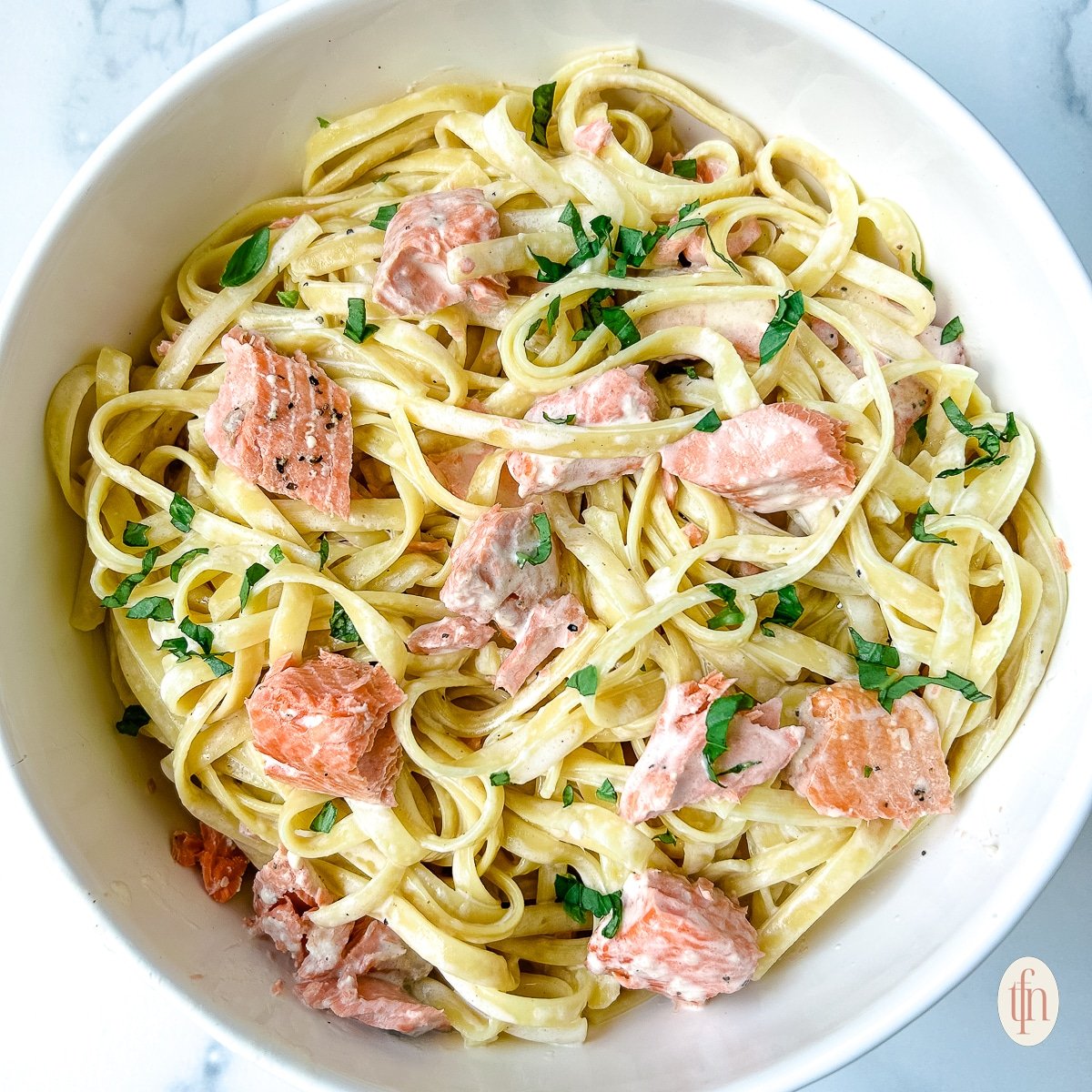

Leave a Reply